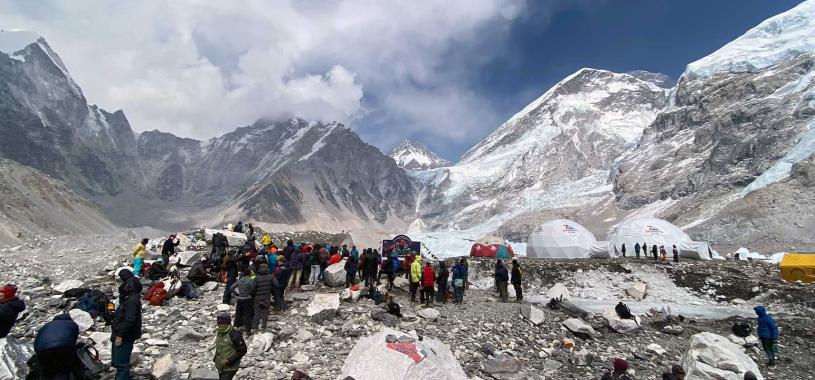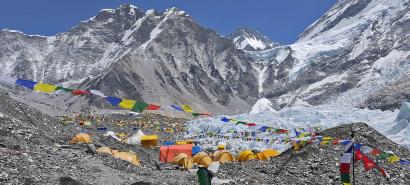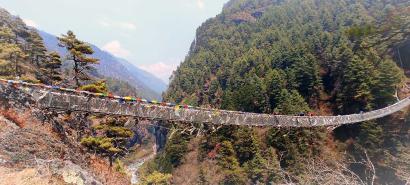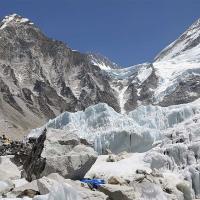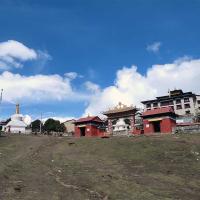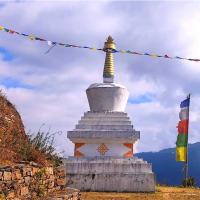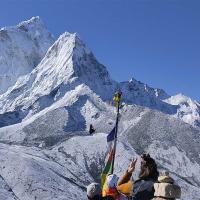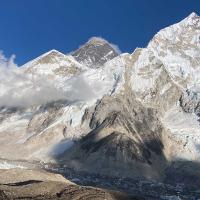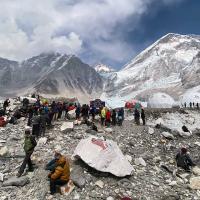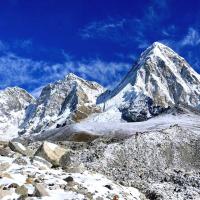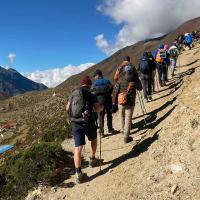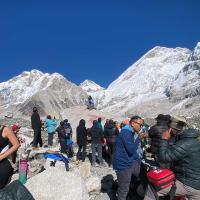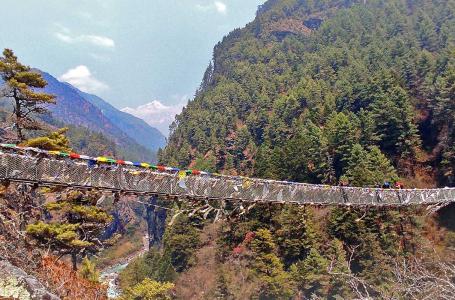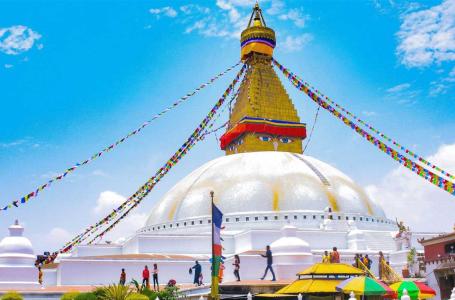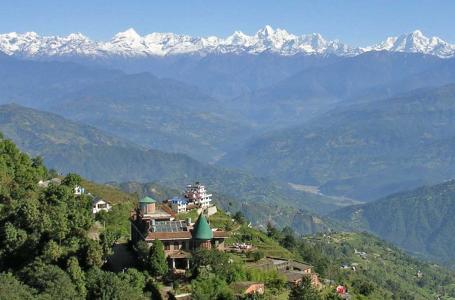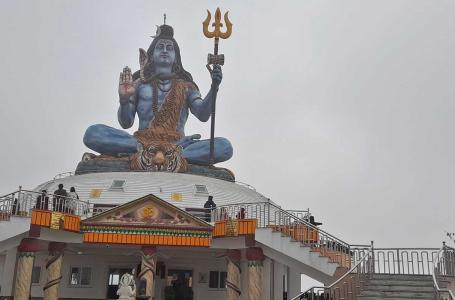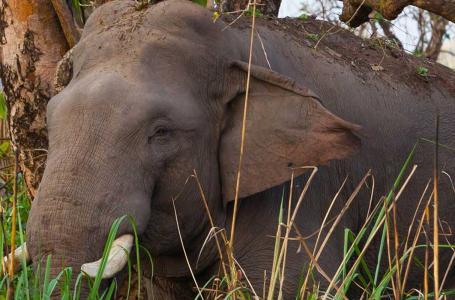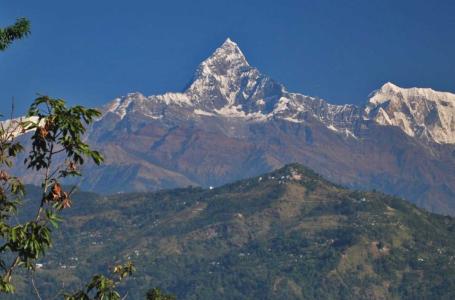- 01Pax USD 1575 pp
- 02 to 05Pax USD 1375 pp
- 06 to 10Pax USD 1175 pp
- 11 to 15Pax USD 1085 pp
Overview
In General, Everest is mistakenly regarded as the ultimate trekking destination: a place that must be visited at the end of life, that puts an end to the cycle of adventure cravings, or something as liberation from the world of adventure. But it is a false idea that started of nowhere, without a rational ground, and ended up being the most popular marketing quote.
In fact, trekking on Everest is a beginner’s adventure. It is the journey of life that teaches us to be patient and hard-working, which is required in every single phase of our entity. You will pass by the cascading waterfalls, thunderous rivers, soul-piercing glaciers, dramatic animation of the mountains, pristine and icy blue glacial lakes, bizarrely narrow stone stairs, quaint farmhouses, and intoxicating monasteries to finally step into the unparalleled base camp of the Mt. Everest, under the roof of the world.
Plus, trekking on Everest is the art of defeating one’s own fear and standing on top of our goals and aspirations. You will battle with the icy winds, jagged trails, low oxygen and rigorously pressurizing altitude to finally arrive at the destination. How can a traveler implement these inspirations into something noteworthy in his life if he is trekking in the Everest during the end of his life’s adventure?
Therefore, try the Everest Base Camp Trek as a beginner and gain something noteworthy in your life.
With this package, you can explore Everest region in a short time: safely and adequately.
Planning the Everest Base Camp Trek:
Trekking to Everest Base Camp (EBC) is an exciting activity that requires meticulous planning to ensure a safe and memorable expedition. To begin, choose the appropriate season and check you have the proper licenses. Similarly, planning a well-thought-out itinerary is critical, including acclimatization days to reduce altitude-related dangers. You can hike with a friend or with the aid of local guides and porters for navigation and support.
Warm clothes, a sleeping bag, and waterproofs are required but pack effectively to save weight. Likewise, physical fitness and altitude training should be part of your pre-trek preparations, and complete travel insurance for medical emergencies and evacuation is required. Responsible hiking that adheres to Leave No Trace principles and respects local customs adds to the region's sustainable tourism.
By following these necessities, you are ready to have fun on your trip to one of the world's most famous trekking destination!
The best time to do the Everest Base Camp Trek?
During the autumn season (September to November) is ideal for this Everest Base Camp Trek. The weather is warm, and your boots' grip on the frozen terrain may hold, making it simpler for us to climb. In addition, during these months, you might look for a group (any trekker) to accompany you throughout the trip.
The spring season (March, April, and May) is also ideal for hiking, however, there is a risk of avalanches.
Monsoon and summer seasons (June, July, and August) are not ideal for an Everest Base Camp trek. Likewise, the cold of winter (December, January, and February) is intolerable for the average trekker.
Foods and Accommodations during EBC Trek:
Because there is no direct flight from Kathmandu to Lukla, visitors must drive for four hours (by shared Hiace Van) from Kathmandu to Manthali Airport. This is because to high traffic at Kathmandu's international airport (October-November and March-April).
Then we'll fly directly from Rameechap Manthali Airport to Lukla Airport). If you wish to go by private vehicle, you must pay an extra fee of USD 100. In terms of flight time, passengers should check out about 1 a.m. for a same-day departure.
If you want to stay one night in Ramechap for the same-day flight, you will be charged a hotel fee of around USD 20 per person.
Transportation to reach Everest Base Camp:
Because there is no direct connection from Kathmandu to Lukla, travelers have to travel for four hours (shared Hiace Van journey) from Kathmandu to Manthali Airport. This is due to heavy traffic at Kathmandu's international airport (Oct-Nov and March-Apr).
We will then take a direct flight from Rameechap Manthali Airport to Lukla Airport). If you want to travel by private vehicle, an additional cost of USD 100 must be paid. In terms of flight time, Travellers should plan to check out at about 1 a.m. for the same-day flight.
If you opt to remain one night in Rameechap for the same-day flight, you will be charged an additional amount for the hotel, which will be approximately USD 20 per person.
Moreover, if you would like to escape the Lukla flight and embark on the Classic Everest Base Camp Trek route, there is an option to trek to Everest Base Camp via Jiri.
Necessary Permits & TIMS:
In order to visit the territory, Everest requires three sorts of permits. A Trekker's Information Management System (TIMS) Card is no longer required. These permissions can only be obtained from licensed agencies, and no freelancing guide can give them.
Khumbu Pasang Lhamu Rural Municipality Entrance Permit:
This permit is intended to supervise and handle tourism activity in the Khumbu region. It is necessary across the Khumbu region, including Namche Bazaar, Tengboche, Dingboche, and Gorakshep, and is valid till Jiri.
Cost: NPR 3000 Per Person for each foreigner.
Sagarmatha National Park Entry Permit:
The purpose of this permit is to restrict and manage entry to the Sagarmatha National Park in order to preserve its natural beauty and biodiversity. The cash collected by these permits is utilized to conserve and maintain the park.
Cost: NPR 3000 Per Person for each Foreigner
Additional Permit for Jiri to Everest Base Camp Trek:
While entering EBC via Jiri, an extra permit for the Gaurishankar Conservation Area is required till we reach the Everest Base Camp Trek.
Cost: NPR 3000 Per Person for each foreigner.
(All the permits required are included in this package).
Necessary documents for Permits:
You will only need your valid passport photocopy (validity of 6 months).
Highlights
- Majestic Mount Everest
- Sherpa Culture and Ethics
- Strenuous Trekking Route
- Kalapatthar- majestic viewpoint
- Tengboche Monastery
- Nepal’s biggest Khumbu and longest Ngozumpa glaciers
- Hillary Museum
- Sagarmatha National Park
- Traditional Sherpa villages, culture, traditions & hospitality
Itinerary
In the peak trekking season, there is a flight available from Ramechhap to Lukla. The journey from Kathmandu to Ramechhap takes approximately 5 hours by road, where you will need to catch a bus from Thamel around 1.30am. You will reach at Ramechhap airport around 6.30am and then proceed to wait for your flight to Lukla. However, during off-peak times, you have the option to fly directly from Kathmandu airport to Lukla.
Early in the morning go to the airport for the flight to Lukla. It is a scenic flight over the gorgeous valleys with views of the mountains and ridges accompanying all the way up to the Lukla. While at times, you may be frightened by the sharp-looking ridges below. But, it is okay to have that thought for an adventurous experience.
On arriving at the airport at Lukla, with the shortest runway, we will start-off our trekking towards Phakding. We will walk along the silent trail, fenced by the farm-fields on both side, and pass by several Mani walls. There are suspension bridges, connecting the two isolated hills, where we will walk through in a hope of encountering a fabulous viewpoint. Consequently, the snowy peak of Kusum Kanguru could be witnessed at some point. Down the village of Ghat, we will finally make an appearance at the Phakding.
This day is one of the challenging days of the whole Everest Base Camp Trek.
For the first few couple of hours, we will contour around the west side of the Dudhkoshi River and waver up and down along the frequent switchbacks on the trail. On the way, we will encounter a pleasant waterfall at the nice village of Toctoc. We will continue to walk, but just before arriving at the Bengkar, we will see another waterfall at Bengkar. You may as well try the apple pies of this region.
A brief ascent to Monjo will introduce us into the naturally exotic forest of Sagarmatha National Park. There are chances of witnessing the Blue Sheep, but only the luckiest few people have seen the red Panda here.
We will continue through the Jorsalle towards the Namche.
During the final ascent of the forest, there is a viewpoint overlooking the gorgeous views of the Everest. It can only be witnessed on a clear day. A beautiful Kani Gate and a chorten welcome us to the village of Namche.
[Note: Red Panda is a Shy creature. So, it doesn’t show off quite often.]
Namche is the ancient trading center of Tibet and India. It receives most of the sunlight during the day, distracting the icy cold of the mountains miles away. Plus, there are many side trips branching off from the Namche, making it an ideal spot for acclimatization. Nevertheless, this place is itself a vibrant place to explore.
A historic museum at Namche displays ancient artifacts and extensive cultural monuments of Sherpas. This is a good place to learn about the history of mountains and their connection to the Sherpas. Moreover, a side hill trip at Namche will reward you with the unparalleled views of the Everest and its surrounding peaks.
From Namche, there are two options for an exciting side trip. While one takes you to an amazing viewpoint of Thame, the other one takes you across the quaint monasteries and traditional villages of the Khumjung and Khunde. It is upon you which one to choose. Later, we will return to our lodge at Namche.
From Namche, the trail leads off along the right-most trail through the memorial stupa of Tenzing Norgay Sherpa, the first person to summit the mountain Everest with the Sir Edmund Hillary. We will walk through the woods and extrude out into a viewpoint, offering sensational views of the Ama Dablam, Lhotse Shar, Taboche, Kangtega, and Thamserku.
We will continue our journey through the Phunke Tenga. Just before crossing a suspension bridge, there is a line of 7 water-driven prayer wheels, spinning with the pace of the river. One spin of the prayer wheel is similar to chanting the Buddhist Mantra of ‘Om Mane Padme Hum’. It is believed to be the good luck for the passerby.
Within a couple of minutes, we will introduce ourselves into the meadows of Saso Kharka and then, proceed to Tengboche. Don’t miss out the visit to the Tengboche Monastery, the largest monastery of the Khumbu region.
Early in the morning, we will attend the prayer ceremonies at the Tengboche Monastery and then, explore the interiors and exteriors of the monastery. The fine paintings of the Buddha and Guru Rinpoche, hung around the wall, are the masterpiece of traditional artistry of Khumbu region.
We will proceed to the Deboche where the views of the Ama Dablam, and other peaks gradually rise to spark a moment of happiness in your soul. Soon, the trail meets a bridge, crossing which keeps us to the west of the Imja Khola. The large black overhanging rocks, on the way, used to provide shelter for the porters and ponies in the past when there was no facility of lodges to stay. The trail continues through the Somare, parallel to the Imja Khola, until we arrive at the Dingboche, our next station.
Dingboche is a traditional village, typically with the stone houses, where the farm-fields and settlement area are surrounded by 4 feet (rough estimate) stone walls to protect them from the heavy winds. The people of this village greatly rely on yaks for living, and yak husbandry is their primary profession.
At Dingboche, a stone wall, guarding the one side of the field, extends to kilometers of length. According to the locals, this stone wall is the unintentional creation of years of stone deposition. When the farmers plowed their field, they separated the rocks and stones from the soil and kept it on the side of their fields. Later, these stones got piled up one over the other to form a long and beautiful stone wall. The broad base of these walls, somewhat, makes us believe this mythical story.
From Dingboche, there are two side trip options. While one goes to the Chhukung Ri, we will catch the other way to Nangkar Tshang hill (often confused as the Nagarjun Hill of Kathmandu) overlooking the gorgeous views of the mountains. On the way, we will pay a brief visit to the Nangkar Tshang monastery and continue through the pleasant woods to the top of the hill. While inside the forest, the chirping sound of the birds and insects create a melodious environment, encouraging us to continue our journey.
On the top, the views of the snowy ranges are totally dramatic. We will see the best views of the Makalu, Chhopulu, Lhotse, Lhotse Shar, and the Island peak. It is amazing to be on top of the Nangkar Tshang hill. Later, we will descend to the Dingboche for the overnight stay
The walk to Lobuche is mostly along the moraine. This route from Dingboche to Lobuche can be divided into two parts, in terms of their distinct trails.
In the first part of the journey, we will ascend over the moraine and walk along the ridge, sometimes through the pastures, until we make up to the nice village of Dughla. While on the ridge, we may witness few mountains on the north, but the haze will cover all the views, most of the time. When we arrive at the Dughla, our second part of the journey begins.
We will have already left the ridge, so we will proceed along the steep bluffs until making an appearance at the Lobuche. The second part is a bit of a tough climb. Once we are on the Lobuche, the reminiscing views of the Nuptse peak cannot be overlooked. It can be seen from the window of the lodge as well on a clear day.
Certainly, this is the big day as we are about to enter into some of the exquisite viewpoints on earth. But, it is good to control your emotions and go slow on the trail. Otherwise, the altitude may ruin all the good aspects of coming so far to the base camp of the Everest.
Before the darkness is swept by the sunlight, we will proceed to the Gorakshep from Lobuche. It is because in the first few hours of the morning, the pacing icy winds from the glaciers will resist our pace, making our trek more challenging to do.
Once we reach the Gorakshep, we will proceed to the awesome view point of Kalapatthar. This place is so extraordinary that you will have to slap your own cheek to become aware of the reality. The 3600 panorama of the mountains, particularly the Mount Everest, appears sensational. The glaciers and surrounding peaks of the Ama Dablam, Thamserku, and Kantega could be distinctly observed. But, the real animation is brought by the countless tiny anonymous buttresses, which have been guarding the soul of the mountains for ages.
Later, we will descend to the Gorakshep for the overnight stay.
[Note: The sunset view from the Kalapatthar is more exquisite than the sunrise view. Therefore, instead of going to the Everest Base Camp (EBC) (as in customary itinerary), we will go to Kalapatthar on this day.]
We will wake up early in the morning and leave to the Everest Base Camp (EBC) to experience the feeling of being on top of the world. The path is slippery, and sometimes, it goes through the narrow bluffs of snow making it difficult to proceed. But, once you are on the base camp of the Everest, the joy is unparalleled.
It is an emotional moment, which in many times becomes a teary moment. But, it is equally inspiring as well. There are camps, set in the base camp by the climbing team of the Everest. In a clear day, the views of the mountains can be fabulous, but nothing in comparison to being on top of the world.
After spending some quality moment on top of the Everest, we will return to the Gorakshep for lunch. After lunch, we will retrace our steps back to Dughla via Lobuche. Instead of proceeding towards the Dingboche, we will head off towards the Pheriche, a quicker option to reach the Namche.
From Pheriche, we will go down the route of Tengboche to arrive at the Namche.
A trek to Lukla takes us along the same trail that we have been earlier.
Finally, we will leave Lukla, as early as possible, over the same intoxicating hills and mountains to finally arrive at Kathmandu. You may as well go for shopping around the markets of Thamel
Cost Details
- Airport pickup and drop service.
- Hotel in Kathmandu. (Hotel Chhimeki 2night)
- All food and accommodation during the trek.
- Transportation costs: Comfortable Drive from Hotel to Airport to Hotel.
- Flight ticket from Kathmandu to Lukla to Kathmandu.
- Government license holder English-speaking trekking guide.
- Trekking permits: Sagarmatha National Park Area fees.
- First aid medical box.
- T-shirt, Duffel Bag, and Trekking Map.
- Rescue Management Service.
- All Tax 13% VAT+10% Service charge).
- Farewell Dinners
- All kinds of Drinks.
- Visa fee to enter Nepal.
- International flight tickets and extra baggage charges
- Extra night accommodation and meal costs in Kathmandu due to any change in the scheduled itinerary
- Travel insurance/ Rescue operation costs.
- All required trekking gear like sleeping bags and down jackets made available on rent.
- All personal expenses (laundry, electronic device. charging cost)
- Tip for guide and porters.
- Hot and cold Shower.
Trip Map
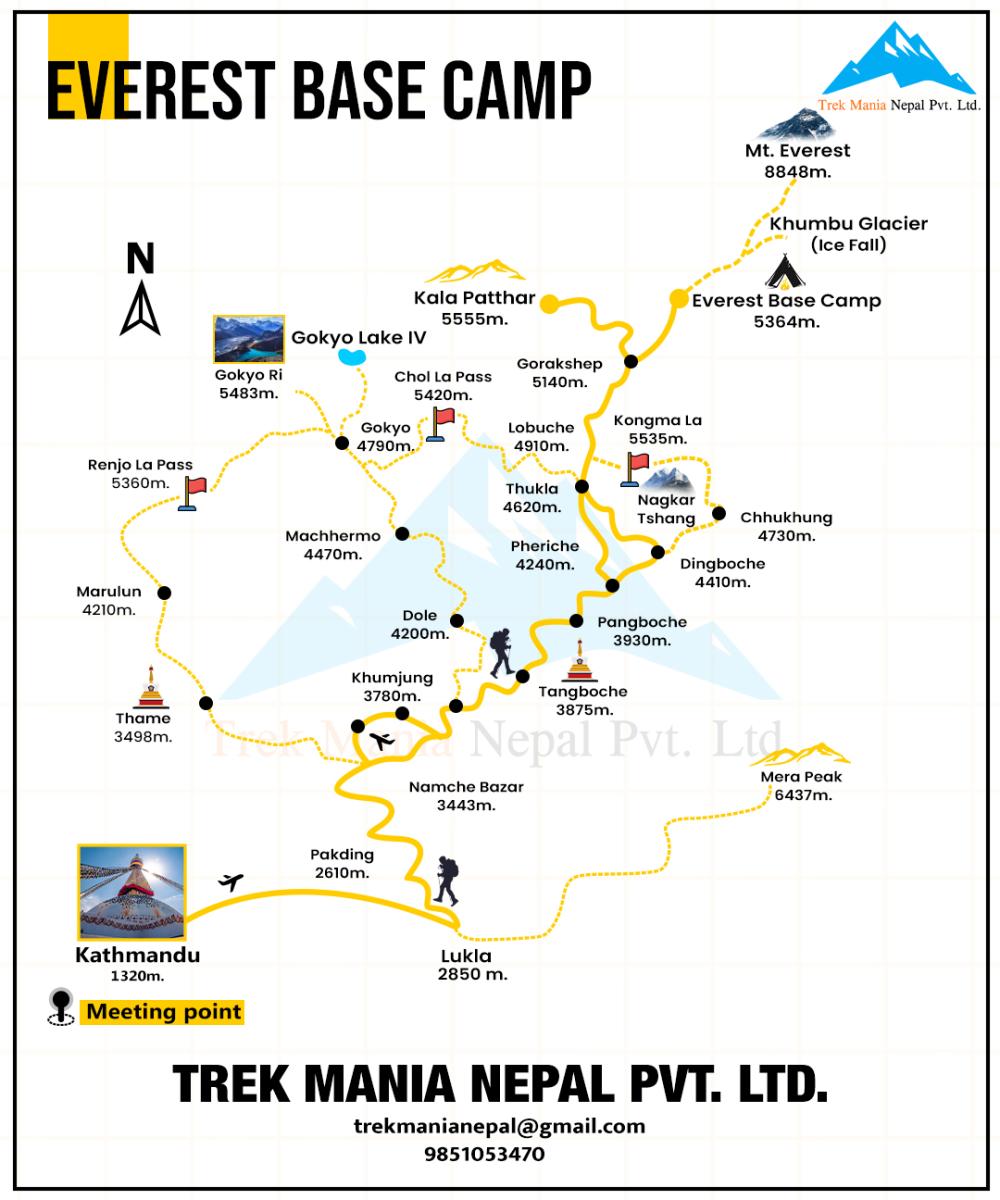
Dates & Pricing
Trip Start and End Point
Kathmandu / Kathmandu
| DATES | STATUS | PRICE | SPACE LEFT | ||||
|---|---|---|---|---|---|---|---|
|
Start date: 18-Jun, 2025
End date: 29-Jun, 2025 |
Guaranteed | USD 1575 |
2
|
Book Now | |||
|
Start date: 27-Jul, 2025
End date: 07-Aug, 2025 |
Guaranteed | USD 1575 |
1
|
Book Now | |||
|
Start date: 15-Aug, 2025
End date: 26-Aug, 2025 |
Guaranteed | USD 1575 |
3
|
Book Now | |||
|
Start date: 19-Aug, 2025
End date: 30-Aug, 2025 |
Guaranteed | USD 1575 |
2
|
Book Now | |||
|
Start date: 09-Sep, 2025
End date: 20-Sep, 2025 |
Guaranteed | USD 1575 |
2
|
Book Now | |||
|
Start date: 21-Oct, 2025
End date: 01-Nov, 2025 |
Guaranteed | USD 1575 |
2
|
Book Now | |||
|
Start date: 21-Nov, 2025
End date: 02-Dec, 2025 |
Guaranteed | USD 1575 |
2
|
Book Now | |||
|
Start date: 09-Dec, 2025
End date: 20-Dec, 2025 |
Guaranteed | USD 1575 |
1
|
Book Now | |||
|
Start date: 15-Dec, 2025
End date: 26-Dec, 2025 |
Guaranteed | USD 1575 |
3
|
Book Now | |||
Equipment List
- Woolen shirts and thick sweaters.
- Jackets (Fiber or down).
- Waterproof jacket with hood or poncho.
- Tracksuit, Track shoes, and Trousers.
- Thermal Underwear and Thermal Coat.
- 2 pairs of loose-fitting long shorts/ skirts.
- Pair of Gloves and sandals.
- Woolen hat and long-sleeved shirt.
- Lightweight walking boots.
- 2 pairs of thin socks and 2 pairs of woolen socks & neck gaiter.
- Snow glasses and sunglasses.
- Trekking Sticks and Duffle bag or kit bag to carry to gear while trekking.
- Some (small/large) plastic bags to separate clean clothes from dirty ones and some smaller plastic bags to dispose of garbage.
- Daypack bag to carry your personal requirements.
- Water Bottle, water purifying tablets.
- Towels, Umbrella (optional).
- Headlamp, Binoculars, Camera, trekking map and compass, reading materials, pencil, rubber, pen, notebook & moisturizer for lip, face body.
FAQs
The Everest Base Camp (EBC) trek is a moderate to challenging journey, requiring 5 to 7 hours of daily trekking on rugged mountain trails. While prior trekking experience helps, beginners with good fitness levels and proper preparation can complete it. At Trek Mania Nepal, we provide expert guides, personalized itineraries, and acclimatization plans to make your adventure safe and enjoyable.
At Trek Mania Nepal, we offer a hassle-free trekking experience with licensed guides, comfortable accommodations, and customized services. Our team prioritizes safety, customer satisfaction, and authentic cultural experiences. With years of experience organizing Everest treks, we ensure the best itinerary, expert altitude management, and seamless logistics, making your journey truly unforgettable.
The best seasons for the Everest Base Camp Trek are spring (March-May) and autumn (September-November). These months offer stable weather, clear mountain views, and pleasant temperatures. Trekking during winter is possible but requires extra gear for extreme cold. With Trek Mania Nepal, we help you plan your trek during the best conditions for a smooth and breathtaking adventure.
Our Everest Base Camp trek includes clean and cozy teahouse lodges along the route. Rooms are twin-sharing with warm blankets. The teahouses serve hearty meals like Dal Bhat, noodles, soups, and Tibetan bread, keeping you energized. At Trek Mania Nepal, we handpick the best lodges to ensure quality service, hygiene, and comfort at high altitudes.
Yes, high-altitude travel insurance is mandatory for EBC treks. Your insurance should cover emergency evacuation, medical expenses, and trip cancellations. At Trek Mania Nepal, we assist in choosing the right insurance policies and offer 24/7 emergency support to ensure a safe and worry-free trekking experience.


